IsoMET at Goldschmidt 2024
21.08.24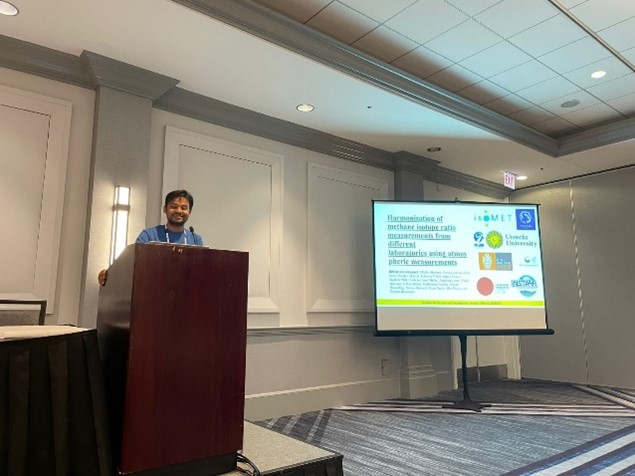
Bibhasvata Dasgupta of project partner Universiteit Utrecht (above) recently provided an oral presentation. Harmonisation of atmospheric methane isotope ratio measurements from different laboratories: Procedures and Protocols was presented at the Goldschmidt 2024 Conference in Chicago which took place August 18th – 23rd at The Hilton Chicago.
Bibhasvata also conducted a workshop along with other speakers from the isotopologues community (above). IsoSchool aims to bridge the knowledge gap in stable isotope geochemistry by offering a two-day workshop focused on isotopologues of simple molecules with rare heavy isotopes, such as carbon (13C) and oxygen (17O or 18O). This workshop will cover methodologies, instruments, and applications in Earth Sciences, featuring lectures on clumped isotopes (Δ47, Δ48, Δ13CH3D, Δ12CH2D2) and the triple oxygen isotopic system.
 Regarding the workshop, Bibhasvata says – ’We presented a synthesis of data from eight laboratories with experience in high-precision isotope ratio mass spectrometry (IRMS) measurements for CH₄ isotopes. The analysis relies exclusively on routine atmospheric measurements conducted at high-latitude stations in the Northern and Southern Hemispheres. The evaluation of routine measurements allows us to monitor interlaboratory offsets over time in addition to analytical and logistical methods of inter-calibration. After applying the overall interlaboratory offsets, we report a harmonized time series for δ¹³C-CH₄ and δD-CH₄ at high northern and southern latitudes, covering the period from 1988 to 2023’.
Regarding the workshop, Bibhasvata says – ’We presented a synthesis of data from eight laboratories with experience in high-precision isotope ratio mass spectrometry (IRMS) measurements for CH₄ isotopes. The analysis relies exclusively on routine atmospheric measurements conducted at high-latitude stations in the Northern and Southern Hemispheres. The evaluation of routine measurements allows us to monitor interlaboratory offsets over time in addition to analytical and logistical methods of inter-calibration. After applying the overall interlaboratory offsets, we report a harmonized time series for δ¹³C-CH₄ and δD-CH₄ at high northern and southern latitudes, covering the period from 1988 to 2023’.
A link to IsoSchool can be found here.
NPL at the 22nd WMO/IAEA Meeting on Carbon Dioxide, Other Greenhouse Gases, and Related Tracers Measurement Techniques (GGMT-2024)
08.08.24
Project partner NPL participated at the WMO/IAEA biannual meeting that was held at INPE, São Jose dos Campos, Brazil 5th – 8th August. Paul Brewer attended in person and Chris Rennick, Dafina Kikaj and Ruth Pearce participated online.
Four presentations were given on NPL work on measurement and traceability of greenhouse gases and tracers. These were Supporting the global measurement infrastructure and reporting values on a common scale presented by Paul Brewer, Direct high-precision radon quantification for interpreting high frequency greenhouse gas measurements presented by Dafina Kikaj, Measurements and calibration for high precision continuous monitoring of stable isotope ratios in atmospheric methane presented by Chris Rennick and Large-scale production of traceable Isotopic Methane Gas Reference Materials presented by Ruth Pearce.
Paul Brewer also led the discussion for updates to section 2 of the report on "Recommendations for the determination of uncertainty" in greenhouse gas measurements.
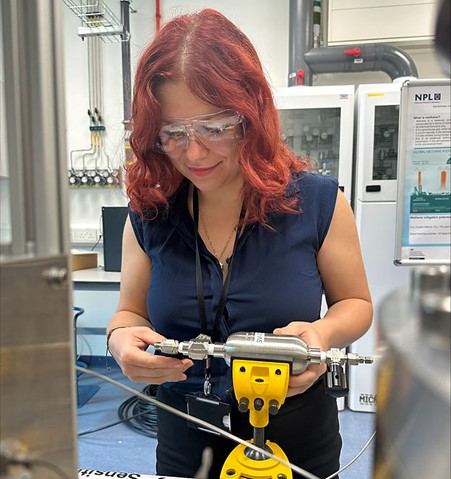
NPL present seminar Development of automated preconcentrator
to measure clumped isotopologues of
methane (Δ13CH3D and Δ12CH2D2) from the atmosphere and sources
03.07.24
Sara Defratyka of project partner NPL, gave an invited talk to the isoNET network, in our progress toward understanding Δ13CH3D and Δ12CH2D2. The seminar Development of automated preconcentrator to measure clumped isotopologues of methane (Δ13CH3D and Δ12CH2D2) from the atmosphere and sources was held online on the 3rd July.
NPL provide training to ULTRA
12.04.24
Sara Defratyka of project partner NPL, provided a training course on the project at the ULTRA User meeting, held by the International Centre for Isotope Effects Research (ICIER), Nanjing University, China 12th April 2024. Sara’s training session focussed on the preconcentrator system at NPL for Δ13CH3D and Δ12CH2D2.
IsoMET at the BASIS Symposium 2024
07.05.24
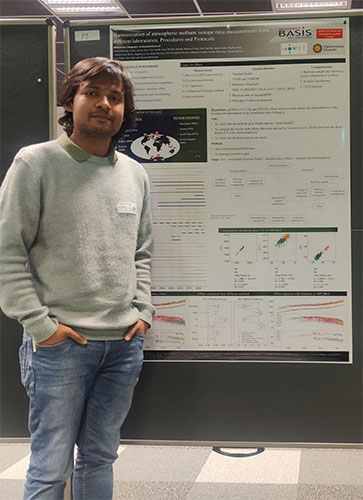 Bibhasvata Dasgupta (right) of project partner Universiteit Utrecht recently provided a poster presentation. Harmonisation of atmospheric methane isotope ratio measurements from different laboratories: Procedures and Protocols was presented at the BASIS Symposium 2024 which took place April 25th – 26th at the Congress Centre Amsterdam Science Park.
Bibhasvata Dasgupta (right) of project partner Universiteit Utrecht recently provided a poster presentation. Harmonisation of atmospheric methane isotope ratio measurements from different laboratories: Procedures and Protocols was presented at the BASIS Symposium 2024 which took place April 25th – 26th at the Congress Centre Amsterdam Science Park.
As atmospheric trace gas isotope measurements get more common and analytical techniques become more diverse, combining, and merging observational records is challenging because of significant offsets between measurements from different laboratories. To address calibration challenges in atmospheric science, we need to standardise calibration procedures, conduct regular inter-laboratory comparisons, provide adequate training and education, use accurately characterised reference materials, continuously improve calibration procedures, and encourage collaboration and communication between laboratories and research institutions. The most recent worldwide comparison among laboratories, concentrating specifically on the IRMS measurement method and encompassing analyses carried out from 2003 to 2017, revealed disparities of up to 0.5 ‰ for δ13C and 13 ‰ for δ2H isotope ratio measurements in ambient air samples. These differences are equivalent to 25 and 13 times the compatibility targets set by the WMO-GAW network, respectively.
BASIS (Benelux Association for Stable Isotope Scientists) originated from the previous Benelux Isotope Group (BIG), a group of active scientists that organized annual meetings without a formal organisation. BIG started in 2000 as an Isotope Ratio Mass Spectrometry (IRMS) users group and has gathered every year since.
A successful M18 meeting for isoMET
01.05.24
A successful M18 meeting for the isoMET project was held online by project partner PTB at the General Assembly 2024 of the European Geosciences Union (EGU) in Vienna, Austria in April. Javis Nwaboh (PTB) coordinator of the project and welcomed all to the meeting. This was followed by presentations on work progressed under WP1 (Developing a harmonised in situ CH4 isotope dataset of ambient air in Europe) by Javis Nwaboh and associated partners NPL, TUBITAK, Empa, UU, The University of Glasgow, VTT, Royal Holloway and Bedford New College, UHEI, Université De Versailles Saint-Quentin-En-Yvelines and Stockholms Universitet. Presentations on work progressed under WP2 (A sustainable metrological infrastructure for a dataset for CH4 isotope source signature measurements in Europe) were provided by Joachim Mohn, (Empa) and associated partners NPL, TUBITAK, PTB, Universiteit Utrecht, The University of Glasgow, VTT, Royal Holloway and Bedford New College, Ruprecht-Karls-Universitaet Heidelberg, Université De Versailles Saint-Quentin-En-Yvelines and The University of Bristol.
For WP3 (Atmospheric transport modelling to direct the measurement strategy for optimal emissions estimation and demonstration of emissions estimates from new datasets) progress was presented to the consortium by Tim Arnold (NPL) and associated partners The University of Bristol and Empa.
Presentations on work progressed under WP4 (Creating impact) were provided by Mehr Fatima (VTT). Javis Nwaboh (PTB) provided updates on WP5 (Management and coordination). During the work package presentations and discussions, there was further discussion with the consortium regarding the output of the project and future progress towards M27.
IsoMET well represented at EGU24
01.05.24
The project was well represented by many of the partners at the recent General Assembly 2024 of the European Geosciences Union (EGU) held at the Austria Center Vienna (ACV) in Vienna, Austria.
Arranged by the partners, Session AS3.40 invited contributions from the community working on the use of isotope ratios and other tracers in understanding the sources/ sinks of GHGs to the atmosphere. The session looked at:
- Advances in analytics for GHG isotope ratios or tracers including developments in metrology, e.g. reference materials or methods, to improve sustainability of monitoring,
- Incorporation of isotope or trace gas measurements into models for improved understanding of the sources and/or sinks,
- Studies contributing data on GHG isotope ratio source signatures or tracer/target species emission factors.
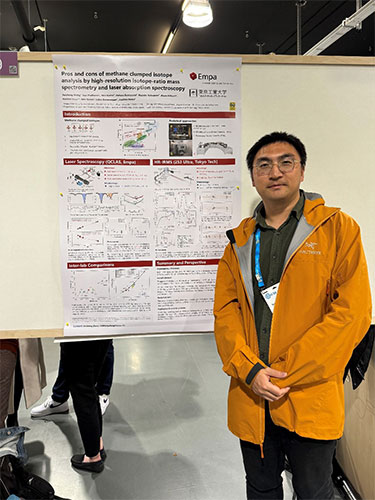
Posters from the project presented at EGU24 from the project included:
- Use of multiple atmospheric chemistry transport models to interpret high frequency methane isotope ratio measurements at independently managed sites by Eunchong Chung, Tim Arnold, Chris Rennick, Emmal Safi, Dafina Kikaj, Brett Thornton, Alistair Manning, Stephan Henne, Anita Ganesan, and Ute Karstens
- Calibration uncertainty of optical isotope ratio spectroscopy measurements of methane and field comparison with mass spectrometry by Christopher Rennick, Cameron Yeo, Freya Wilson, Emmal Safi, Emily Hopkinson, Aimee Hillier, Ruth Pearce, James France, Mathias Lanoiselle, David Lowry, and Tim Arnold
- Quantifying and empirically correcting apparent gas matrix effects: Example measurements for two CRDS analyzers for CO2 and CH4 amount fractions and 13/12C isotope ratios by Javis A. Nwaboh, Jelka Braden-Behrens, Anas Emad, Henning Bohlius, and Volker Ebert
- Isotope Analysis as a tool for climate metrology at PTB: a novel approach to oxygen-17 correction by Olav Werhahn, Lukas Flierl, and Olaf Rienitz
- The isoMET project on ambient CH4 monitoring, source signature information and modelling by Mehr Fatima, Javis Nwaboh, Joachim Mohn, Tim Arnold, and Volker Ebert
 Naizhong Zhang (above) of project partner Empa presented on the Pros and cons of methane clumped isotope analysis by high-resolution isotope-ratio mass spectrometry and laser absorption spectroscopy.
Naizhong Zhang (above) of project partner Empa presented on the Pros and cons of methane clumped isotope analysis by high-resolution isotope-ratio mass spectrometry and laser absorption spectroscopy.
Bibhasvata Dasgupta (right) of project partner Universiteit Utrecht also presented at the EGU on the use of methane isotope measurements to constrain regional scale emissions.
The European Geosciences Union (EGU) is the leading organisation for Earth, planetary and space science research in Europe. With partner organisations worldwide, the EGU fosters fundamental geoscience research, alongside applied research that addresses key societal and environmental challenges. The EGU vision is to realise a sustainable and just future for humanity and for the planet.
 IsoMET at the Observations within the Global Greenhouse Gas Watch
IsoMET at the Observations within the Global Greenhouse Gas Watch
01.11.23
Bibhasvata Dasgupta (right) of project partner Universiteit Utrecht recently provided a poster presentation. The Use of Methane Isotope Measurements to Constrain Regional Scale Emissions was presented at the Observations within the Global Greenhouse Gas Watch, 3rd – 5th October in Geneva.
The purpose of this WMO workshop was to develop guidance from and to Member countries and partner organizations regarding the comprehensive integrated observing system that would support the implementation of the Global Greenhouse Gas Watch (GGGW).
A successful M9 meeting for isoMET
01.07.23
A successful M9 meeting for the isoMET project was held by project partner PTB in June.
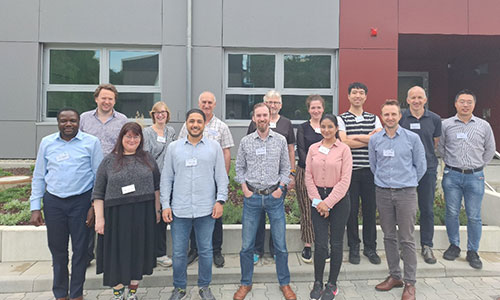 Javis Nwaboh (PTB) coordinator of the project welcomed all to the meeting. This was followed by presentations on work progressed under WP1 (Developing a harmonised in situ CH4 isotope dataset of ambient air in Europe) by Javis Nwaboh and Jelka Braden-Behrens (PTB) and associated partners NPL, TUBITAK, Empa, UU, The University of Glasgow, VTT, Royal Holloway and Bedford New College, UHEI, Université De Versailles Saint-Quentin-En-Yvelines and Stockholms Universitet.
Javis Nwaboh (PTB) coordinator of the project welcomed all to the meeting. This was followed by presentations on work progressed under WP1 (Developing a harmonised in situ CH4 isotope dataset of ambient air in Europe) by Javis Nwaboh and Jelka Braden-Behrens (PTB) and associated partners NPL, TUBITAK, Empa, UU, The University of Glasgow, VTT, Royal Holloway and Bedford New College, UHEI, Université De Versailles Saint-Quentin-En-Yvelines and Stockholms Universitet.
Presentations on work progressed under WP2 (A sustainable metrological infrastructure for a dataset for CH4 isotope source signature measurements in Europe) were provided by Joachim Mohn, (Empa) and associated partners NPL, TUBITAK, PTB, Universiteit Utrecht, The University of Glasgow, VTT, Royal Holloway and Bedford New College, Ruprecht-Karls-Universitaet Heidelberg, Université De Versailles Saint-Quentin-En-Yvelines and The University of Bristol.
For WP3 (Atmospheric transport modelling to direct the measurement strategy for optimal emissions estimation and demonstration of emissions estimates from new datasets) progress was presented to the consortium by Tim Arnold (NPL) and associated partners The University of Bristol and Empa.
Presentations on work progressed under WP4 (Creating impact) were provided by Mehr Fatima and Thomas Hausmaninger (VTT). Javis Nwaboh (PTB) and Tim Arnold, (NPL) provided updates on WP5 (Management and coordination). During the work package presentations and discussions, there was further discussion with the consortium regarding the output of the project and future progress towards M18.
IsoMET Stakeholder Workshop
20.06.23
The isoMET project partners held a Stakeholder Workshop online on the 13th June 2023. Javis Nwaboh (PTB) coordinator of the project welcomed all to the meeting. This was followed by A presentation on WP1 (Developing a harmonised in situ CH4 isotope dataset of ambient air in Europe) by PTB. A presentation on work progressed under WP2 (A sustainable metrological infrastructure for a dataset for CH4 isotope source signature measurements in Europe) was provided by Empa. WP3 (Atmospheric transport modelling to direct the measurement strategy for optimal emissions estimation and demonstration of emissions estimates from new datasets) progress was presented by NPL. VTT presented on WP4 (Creating Impact).
During the work package presentations and discussions, there was further discussion between the consortium and the stakeholders regarding the output of the project, further stakeholder engagement and future progress towards M18.
IsoMET at M9
01.03.23
The isoMET project partners will come together to discuss current progress and work towards M18 at PTB in Braunschweig, Germany, June 2023.
A successful Kick Off meeting for isoMET
23.11.22
A successful Kick Off meeting for the isoMET Project was held by PTB on the 22nd November. Due to the current pandemic situation, the meeting was held online with all project partners in attendance.
Javis Nwaboh and Volker Ebert of PTB welcomed all the partners to the first meeting of this new project. Tim Arnold (NPL) provided an overview of the project overall, and Javis and Anas Emad (PTB) provided a summary of what is required under WP1.
Joachim Mohn (EMPA) took the partners through an overview of WP2, and Tim presented on WP3. Mehr Fatima and Thomas Hausmaninger (VTT) provided an overview of WP4.
EURAMET provided the presentation Guidance on the Metrology Partnership’s impact generation and reporting to the partners, and this was followed by Javis, Volker and Tim providing everyone with an overview for all partners requirements towards WP5.